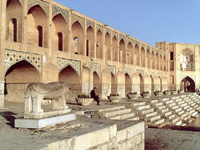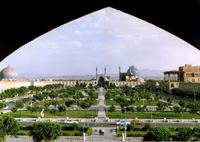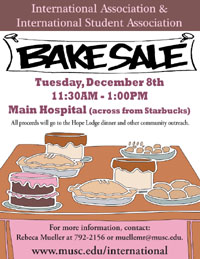|
Editor's
note: Welcome to the Global Health page. The purpose of this feature is
to raise awareness of global health issues with an academic spirit to
help improve the quality of care provided to patients. E-mail
globalhealthnews@musc.edu.
by Pouya Tahsili-Fahadan, M.D.
Department of Neurosciences
Iran, which means “land of Aryans,” was formerly known as Persia. It is
the 18th largest country in the world with more than 70 million people.
Persian urban civilization dates back to 7000 BC. Zoroastrian Iran was
conquered by the Arabs 14 centuries ago and gradually turned into a
country with a majority of Shiite Muslims. Iran got its unofficial
independence from the Islamic empire four centuries later.
Surprisingly, the language of the country remained Persian. In the 20th
century Iran experienced two revolutions: the first, a constitutional
revolution leading to parliamentarism in 1906; and the second
revolution in 1979 which ended 25 centuries of monarchy.
 The Khaju Bridge, located in Isfahan, was built in 1667. The Khaju Bridge, located in Isfahan, was built in 1667.
The major cities include
Tehran, the capital and one of the most polluted cities in the world
with a population of more than 13 million; Isfahan, the cultural center
and former capital that houses several UNESCO (United Nations
Educational, Scientific and Cultural Organization) world heritage
sites; Mashhad, a religious city in the Northeast; Shiraz, famous for
its wine and poets, located near the historic capital Persepolis; and
Tabriz, the capital of Eastern Azerbayjan state.
Medical education and research have a long history in Iran. Examples
include the founding of Gondeshapour University in the fifth century, a
description of a cesarean section in the epic, Shahnameh, written by
Ferdowsi in the 10th century, the discovery of ethanol by Rhazes in the
10th century, and the writing of “Canon in Medicine” by Avicenna in the
11th century. Modern clinical medicine started in Iran with the
establishment of the Dar-ol-Fonoun school in 1851 followed by the
University of Tehran in 1934.
 Naghsh-e Jahan Square, officially known as Imam Square, is at the center of Isfahan, Iran. Naghsh-e Jahan Square, officially known as Imam Square, is at the center of Isfahan, Iran.
Biomedical research
slowed significantly after the 1979 revolution which resulted in a
massive immigration of scholars and young investigators to other
countries. Also contributing to this “brain drain” were the eight-year
war between Iran and Iraq, the many political crises between Iran and
western nations leading to 30 years of sanctions against the country,
and insufficient investment in research (less than 0.5 percent of gross
domestic product). However, medical research accelerated significantly
after the “reform government” took office in 1998. Nanotechnology,
biotechnology, pharmaceutical sciences, neurosciences and stem cell
research are among the fastest growing fields. In clinical sciences and
research, hematology (especially bone marrow transplantation),
rheumatology, kidney, liver and heart transplantation, and
gastroenterology have been very successful internationally.
Interestingly, Iran has one of the highest global rates of rhinoplasty.
Clinician’s corner
A 30-year-old woman of Middle-Eastern origins presents with a one -year
history of relapsing painful oral and genital ulcers that heal
spontaneously, pain and swelling of knees and blurred vision. Physical
examination reveals multiple large elevated round aphthous ulcers in
oral cavity, scars of previous genital ulcers as well as elevated
tender nodules on the anterior side of legs. Red injection of eyes is
noticed and further examination indicates uveitis. Pethergy reaction
test is positive. Two uncles of the patient have experienced blindness
and stroke in their 30’s that were treated with corticosteroids and
cyclosporine. What is the most likely diagnosis?
A. Reiter syndrome
B. Behcet disease
C. Rheumatoid arthritis
D. Isolated CNS vasculitis
E. Lupus
The correct answer is B.
Behcet disease is a rare vasculitis more commonly seen in people of
Middle- Eastern origin (although may affect people from all origins)
that most commonly affects oral cavity and genitalia with painful
ulcers that heal spontaneously. Aphthous ulcers are seen in
normal people but are more frequent and larger in Behcet patients. The
above described skin lesion is erythema nodosum. Involvement of eyes
may lead to blindness and vasculitis of cerebral vessles may result in
stroke. Although the etiology is still unclear, it is most probably an
autoimmune disorder. Manifestations may be more severe in males and
elderly. Diagnostic criteria includes: aphthous ulcer less than 3 times
a year plus two of genital ulcers, ophthalmic involvement, dermatologic
manifesta-tions and positive pathergy test. Treatment includes topical
corticosteroids in the form of ointments, mouthwash and eye-drops,
systemic steroids and immunomodulators.
Announcements
World AIDS Day
- AIDS Testing: 9 a.m. - 12:30 p.m., Nov. 30, Colbert Education Center & Library lobby.
- Red Ribbon Sale: Noon, Dec. 1, Colbert Education Center & Library lobby.
- Seminar: 3 p.m., Dec.
1, Basic Science Building Auditorium. Dr. Paul Volberding
pioneered studies of the drug AZT to treat patients with HIV and AIDS.
- Candlelight Vigil Walk, 5 p.m., Dec. 1, Marion Square.
International ‘Sweet and Savory’ Bake Sale
11 a.m. - 1:30 p.m., Dec. 8 at the University Hospital and Colbert Education Center & Library.
International James Island County Park Festival of Lights Trip
Dec. 12. Meet at Jonathan Lucas bus stop at 6:30 p.m.
International New Year’s Lunch
Noon - 1 p.m., Jan. 13, Harper Student Center.

Visit http://www.musc.edu/international.
Friday, Nov. 27, 2009
|





